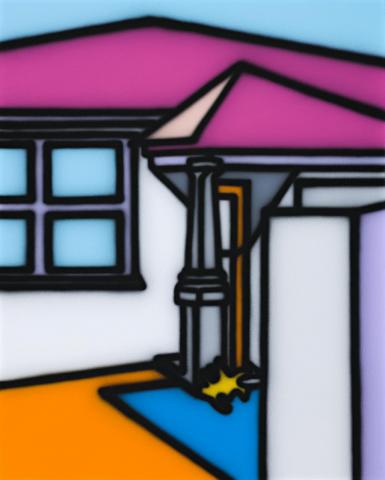COLOUR FIELD HOME, 1999
HOWARD ARKLEY
synthetic polymer paint on canvas
100.0 x 80.0 cm
signed, dated and inscribed verso: Howard Arkley / “Colour Field Home” / 1999
Private collection, Melbourne
McCulloch Gallery, Melbourne
Private collection, Melbourne, acquired from the above in 2007
Possibly Arkley Works electronic catalogue raissoné reference: http://arkleyworks.com/?p=3673 (as'Untitled [House #1]', 1999)
© The Estate of Howard Arkley. Licensed by Kalli Rolfe Contemporary Art
Howard Arkley intuitively found in the spray gun the perfect vessel to tell his story about suburban kitsch, domestic yearning and the delusional fantasy inherent in the replication and adaptation of architectural motifs and forms. Timothy Morrell comments that, 'the essential component of his approach to making art is the instrument he uses for painting, an airbrush that sprays the pigment onto the canvas, resulting in a mass produced appearance.'1 The vivid, implausible hues of his palette and the tell tale out of focus black outlines, hark back to the fetishism of custom painting and yet also heavily allude to graffiti and street art vandalism. Both streams take the everyday object and amplify and distort it thus elevating it to a cult like status. Through the airbrush Arkley's work thus vacillates between what Clement Greenberg referred to as avantgarde and kitsch. It is high art but its subject matter firmly resides in the suburban world of Dame Edna Everage and the Australian film classic, The Castle. Colour Field Home, 1999 explores this juncture brilliantly.
Colour Field Home was painted in 1999, a year that painfully adhered to the ancient Roman laws of fortune for Arkley. It was full of prosperity and promise, yet ended in the artist's tragic and untimely death in July. When the year began, all seemed be aligned for unstoppable success. The National Portrait Gallery in Canberra had commissioned him to paint the head of the iconic punk musician and underground guru, Nick Cave. His remarkable work Homezone was included in the Clemenger Contemporary Art Award to critical acclaim and Zappo Head of 1987 was emblazoned on the façade of Nonda Katsalidis' Republic Tower in Queen Street, Melbourne. More importantly he represented Australia at the 48th Venice Biennale of Art with his monumental celebration of Australian suburban kitsch, The Home Show. The installation transformed Philip Cox's Australian Pavilion, which was ironically designed to appear like a contemporary Australian house, into a psychedelic exposé on domestic life and the elemental, at times conflicting, yearning for shelter, conformism and individual expression encapsulated in the great Australian dream of home ownership.
1. Morrell, T., 'Howard Arkley: The Home Show', in Howard Arkley: The Home Show, Australia Council for the Arts, Sydney, 1999, p. 15
LARA NICHOLLS
